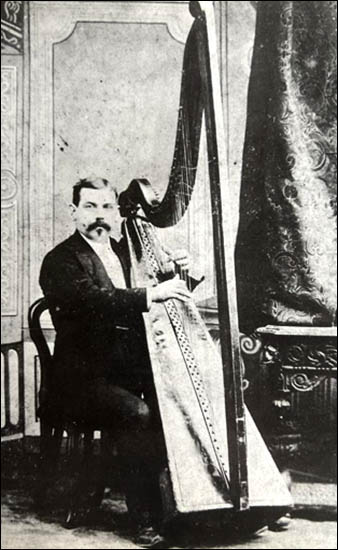Birthplace of triple-harpist Owen Jones, Llannerch-y-Medd
Harpist Owen Jones was born here, in what was then the Britannia Inn, in 1860. He played a Welsh triple harp, made of dark wood, which he won as a teenager at the 1874 National Eisteddfod.
The embossed ‘Britannia Inn’ sign can still be seen on the building. Owen’s father John kept the inn when Owen was born. John was a harpist, known as Telynor Môn, but Owen received harp lessons from his uncle Owen, Telynor Cybi. Owen junior took the name Telynor Seiriol, after a saint associated with Anglesey. His brothers Robert and William were also harpists.
 In the 19th century the Britannia was known as ‘The Home of the Harp’ and attracted artists from across Wales: poets, storytellers, singers and musicians. The Britannia’s harpists preserved an Anglesey tradition said to date back to the 14th century.
In the 19th century the Britannia was known as ‘The Home of the Harp’ and attracted artists from across Wales: poets, storytellers, singers and musicians. The Britannia’s harpists preserved an Anglesey tradition said to date back to the 14th century.
Owen briefly studied at the Guildhall College of Music in London but preferred to play the triple harp (see the footnotes). He returned home saying he didn’t wish to learn any more than he could from his uncle.
Owen was official harpist to the Royal Welsh Fusiliers 1880-83 and to the Gorsedd of Bards. The photo of Owen appeared in the programme of the 1894 National Eisteddfod, where he performed before Queen Victoria’s son (later Edward VII). He played for the royal family on the yacht Britannia.
When not playing his harp, Owen was a tailor in the family business. His workshop was next to the Britannia Inn.
He was a heavy drinker until late in his life, when he turned to faith. He joined the Baptist Chapel, which he left suddenly one Sunday afternoon in April 1906 because he felt unwell. He died a few hours later of a heart attack. According to local folklore, someone present suggested giving Owen some brandy in the hope it would revive him. This wasn’t done for fear it might reawaken his desire for strong drink.
Owen was buried in St Mary’s Churchyard across the road from the Britannia Inn.
With thanks to Ymddiriedolaeth Owen Jones Trust
Postcode: LL71 8DA View Location Map
Website of Ymddiriedolaeth Owen Jones Trust
Website of the Welsh triple harp society
Footnotes: The Welsh triple harp
The concept of a harp with three rows of strings originated in Italy, to cope with the type of music developing during the 16th century. It allows the harpist to play all notes of the chromatic scale without levers or pedals. The two outer rows of the triple harp are tuned to the diatonic scale and the inner row to the accidentals.
Sound effects peculiar to the instrument can be produced by playing the two outer rows in swift succession, a sound unobtainable on any harp with a single row of strings. The triple harp was quickly adopted by Welsh harpers living in London during the 17th century.
It was popular with the Welsh gentry as well as the peasants and its characteristic sound was heard in mansions, humble cottages, taverns and inns, at fairs, dances, eisteddfodau, festivals, weddings and other celebrations. It was so popular that by the beginning of the 18th century the triple harp became generally known as the ‘Welsh harp’. By the middle of that century, the triple harp had fallen out of fashion across the rest of Europe but its use continued in Wales.

